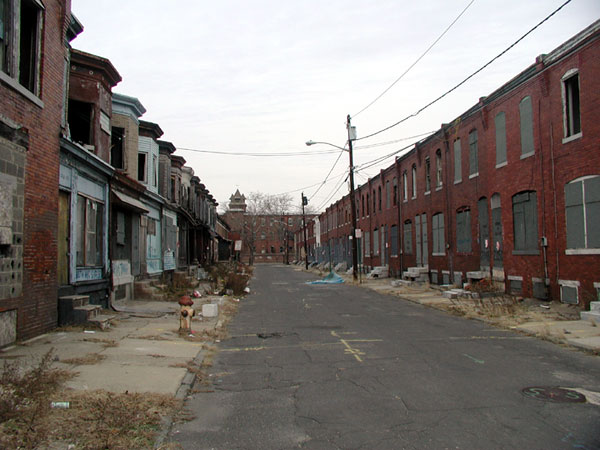Median household income in the United States declined for the second straight year, according to data released from the U.S. Census Bureau today. Income was $50,502 in 2011, more than 8% below the 2007 pre-recession peak.
Read: America’s Poorest States
Read: America’s Richest States
While the trend is generally down, some states fared far better than others. Median income ranged from $36,919 in Mississippi to $70,004 in Maryland, positions both states have held since before the recession. Based on the 2011 Census Bureau American Community Survey, 24/7 Wall St. identified the states with the highest and lowest median household income.
Between 2010 and 2011, Vermont was the only state where median income increased. Income fell in 18 states and remained statistically unchanged in 31. In Hawaii, which remained one of the wealthiest states in the country, median income decreased by more than $3,000 between 2010 and 2011 alone.
Not surprisingly, poverty rates continued to be high. The percentage of Americans living below the poverty line increased in 17 states between 2010 and 2011, the third consecutive increase for ten of these states. Of the states with the lowest income, eight had among the 10 highest poverty rates. Mississippi had the highest poverty rate in the country, at 22.6% of residents, compared to the national rate of 15.9%.
The poorest states in the country are almost entirely found in the South, with the exception of New Mexico. The wealthiest states can be found all across the country, including three in New England, four in the Mid-Atlantic, and two outside the contiguous 48 states.
Of course, not all residents of the wealthiest states earn as much as the median. According to the Census Bureau’s Gini Coefficient, which measures income inequality, there was a significant increase in the divide between the rich and poor in 20 states. The measure remained unchanged in the rest.
Though income inequality affects rich and poor states alike, the poorest states struggle with it most. Inequality was high in only three rich states: California, Massachusetts and Connecticut. Meanwhile, with the exception of West Virginia, all of the poorest states had among the highest income inequality scores, with six in the top 15.
In an interview with 24/7 Wall St., Brookings Institution fellow Elizabeth Kneebone explained that income inequality at a state level is often influenced by differences between the state’s high- and low-income cities and between urban and rural areas. “These are metropolitan economies that drive a lot of these [state] trends.” This was especially the case in California, where the Bay Area’s wealthy suburbs have incomes fueled by the tech industry and the low-income areas in other parts of the states are agricultural-based economies.
At least one positive development involves health insurance coverage, which increased in 37 states. While the poorest states improved, coverage remained relatively low. Three of the poorest states were among the 10 with the lowest coverage. In New Mexico, nearly 20% were not insured in 2011, much higher than the 15.1% national average. In the wealthiest states, coverage was among the highest, with four states having greater than 90% insured.
While most of the states with the lowest incomes suffer from weak economies, unemployment was not a significant problem. Only two states were among the worst 10 for unemployment in 2011. In fact, five of the worst-off states had unemployment rates lower than the national rate of 8.9% last year. In Oklahoma, one of the poorest states, unemployment was 6.2%. In the states with the highest median incomes, the results were similarly varied.
According to Kneebone, it is not a surprise that unemployment and income appear unrelated. “Earnings for middle and lower-wage workers have fallen or stagnated over time,” Kneebone explained. “So you can have a situation where jobs are being created … but the types of jobs matter. If those are jobs that pay low wages, even if you’re working full time, that might not be enough to lift you above the poverty line.”
To identify the states with the highest and lowest median household income, 24/7 Wall St. reviewed state data on income, poverty, and health insurance from the U.S. Census Bureau’s 2011 American Community Survey (ACS). Based on Census treatment, median household income for all years is adjusted for inflation. We also reviewed unemployment data provided by the Bureau of Labor Statistics and additional 2011 ACS data on individual cities. Because the cost of living has a direct bearing income, 24/7 Wall St. considered cost of living data for Q4 2011 from the Council for Community and Economic Research.
These are America’s poorest states.
America’s Poorest States
10. Oklahoma
> Median household income: $43,225
> Population: 3,791,508 (23rd lowest)
> Unemployment rate: 6.2% (8th lowest)
> Pct. below poverty line: 17.2% (16th highest)
Oklahoma remarkably low unemployment rate of 6.2% for a state that is among the nation’s poorest. The poverty rate of 17.2% has inched up each year from the 2008 rate of 15.9%. The low median income suggests a need for higher paying jobs as Oklahoma relies heavily on agricultural production. Also, government and military, which tend to be low-paying jobs, account for the highest percentage of jobs in the state. But Oklahoma is also a major producer of oil and gas. Growth in the energy sector, which tends to pay more, would help improve on Oklahoma’s median income of $43,225.
9. South Carolina
> Median household income: $42,367
> Population: 4,679,230 (24th highest)
> Unemployment rate: 10.3% (8th highest)
> Pct. below poverty line: 18.9% (9th highest)
South Carolina has been hit harder than many states by the recent economic downturn. The state’s sizable tourism industry has slowed as families cut back on vacations. The state’s 10.3% unemployment rate in 2011 was well above the 8.9% national rate. South Carolina’s poverty rate of 18.9% was the ninth highest in the U.S. and significantly higher than the national rate of 15.9%.Moreover, approximately6.5% of families made less than $10,000 a year, the fifth highest proportion in the country. Meanwhile, only 2.9% of families made more than $200,000 a year, the sixth-lowest rate in the country.
Also Read: The World’s Best (and Worst) Economies
8. New Mexico
> Median household income: $41,963
> Population: 2,082,224 (15th lowest)
> Unemployment rate: 7.4% (18th lowest)
> Pct. below poverty line: 21.5% (2nd highest)
Last year, 7.2% of families in New Mexico earned less than $10,000, a larger proportion than in any state but Mississippi and Louisiana. In addition, 21.5% of residents lived below the poverty line, well above the national rate of 15.9%. As a result of poverty and limited job benefits, many New Mexicans cannot afford health insurance. Last year, 19.8% of the state’s residents were uninsured. This was significantly higher than the national rate of 15.1% even though the cost of healthcare in New Mexico was slightly below the national average.
7. Louisiana
> Median household income: $41,734
> Population: 4,574,836 (25th highest)
> Unemployment rate: 7.3% (16th lowest)
> Pct. below poverty line: 20.4% (3rd highest)
Louisiana is located at the center of the poorest region in the country — the Deep South along the gulf coast. When Hurricane Katrina struck the region in 2005, the southern part of the state was decimated, particularly the city of New Orleans. Six years later, the city was still recovering with almost 17% of families earning less than $10,000 per year, more than triple the national rate of 5.1%. By many measures, conditions are actually getting worse in the state. As of 2011, for the first time since Katrina, more than one in five residents lived below the poverty line, only slightly better than Mississippi and New Mexico. Louisiana’s median income fell by more than the country as a whole, falling more than $2,000 between 2010 and 2011.
6. Tennessee
> Median household income: $41,693
> Population: 6,403,353 (17th highest)
> Unemployment rate: 9.2% (16th highest)
> Pct. below poverty line: 18.3% (12th highest)
In Tennessee some 6.1% of families, or about a third of families in poverty, made less than $10,000 in 2012, a percentage point higher than the national figure. Poverty in many of Tennessee’s largest cities is even worse than the state as a whole. In Memphis, the state’s largest city, 27.2% of the population lived below the poverty line, including 13.1% of households earning less than $10,000 a year. In Chattanooga, 28.7% of the population lived below the poverty line, including 16.3% of households earning less than $10,000 annually. While the state’s median income was lower than most, Tennessee had the second-lowest overall cost of living in and the lowest cost of living for housing among all states in 2011.
5. Alabama
> Median household income: $41,415
> Population: 4,802,740 (23rd highest)
> Unemployment rate: 9% (18th highest)
> Pct. below poverty line: 19% (7th highest)
In 2011, Alabama’s median income was more than $9,000 below the nation’s median income, while 6.4% of families lived off less than $10,000 a year — higher than in all but five states. For the second year in a row, Alabama’s poverty rate was 19%, remaining more than three percentage points above the national rate. Despite struggling with poverty, only 14.3% of Alabamians did not have health insurance last year — slightly better than the national figure of 15.1%. It is likely that Alabama’s cheap health care–the least expensive in the country for the fourth quarter of 2011–resulted in more insured residents.According to Gallup, since August of 2011 almost 23% of state residents reported not having enough money to buy food at least once.
4. Kentucky
> Median household income: $41,141
> Population: 4,369,356 (25th lowest)
> Unemployment rate: 9.5% (13th highest)
> Pct. below poverty line: 19.1% (5th highest)
Kentucky’s unemployment rate of 9.5%, while not as high as states such as South Carolina and Mississippi, was well above the national rate of 8.9%. The employment rate will likely stay high in the near future as mining, a major industry in Kentucky, has declined in the past year due to a drop in natural gas prices. Severe poverty plagues the state, as 6.9% of families earned less than $10,000 in 2011, the fourth lowest of all states. Meanwhile, a mere 3% of Kentucky families earned more than $200,000 a year, the seventh-lowest rate in the country. Fortunately for those with lower incomes, Kentucky has the fourth-lowest cost of living in the U.S., including the second-lowest cost of living for groceries.
Click here to see how all fifty states do with 24/7 Wall St.’s new interactive state tool.
3. Arkansas
> Median household income: $38,758
> Population: 2,937,979 (19th lowest)
> Unemployment rate: 8% (tied-25th lowest)
> Pct. below poverty line: 19.5% (4th highest)
While the national median household income fell to $50,502 in 2011, Arkansas was just one of three states where median income remained below $40,000 for the year. Despite an unemployment rate of 8% in 2011, nearly one percentage point below the national rate, the 19.5% of families lived below the poverty line, one of the nation’s highest rates. Poverty was slightly less of a problem in Little Rock, the state’s largest city, which had a 16.4% poverty rate and a median income of $40,976. Despite having the third-lowest cost of health care nationwide at the end of 2011, 17.1% of residents lived without health insurance last year–well above the national figure of 15.1%.
2. West Virginia
> Median household income: $38,482
> Population: 1,855,364 (14th lowest)
> Unemployment rate: 8% (tied-25th lowest)
> Pct. below poverty line: 18.6% (10th highest)
West Virginia’s median income of $38,482 was well off the median income of $40,093 in 2007. The state’s unemployment rate of 8% was well below the 8.9% nationwide. But, like Kentucky, a softening mining sector in 2012 could weaken West Virginia’s economy. The proportion of West Virginia residents without health insurance grew 4.9%, the third-largest increase in the U.S. Fortunately for cash-strapped residents, although the state’s overall cost of living is in the middle of the pack compared to all other states, the cost of groceries is the third lowest in the country.
1. Mississippi
> Median household income: $36,919
> Population: 2,978,512 (20th lowest)
> Unemployment rate: 10.7% (4th highest)
> Pct. below poverty line: 22.6% (the highest)
The median income of the poorest state in the country, Mississippi, was just slightly less than 53% of the median income of Maryland, the richest state. Mississippi’s median income–like many states– fell each year between 2008 and 2011, dropping $2,677 during that time. Not only did Mississippi have the highest poverty rate in the country, but 7.8% of Mississippi families made less than $10,000 in 2011, which was also the lowest rate in the country. While unemployment declined in most states between 2010 and 2011, Mississippi’s actually rose 0.2 percentage points, one of only two states to see an increase in unemployment.
Michael B. Sauter, Samuel Weigley, Brian Zajac and Alexander E. M. Hess
Also Read: America’s Richest States
The Average American Is Losing Momentum On Their Savings Every Day (Sponsor)
If you’re like many Americans and keep your money ‘safe’ in a checking or savings account, think again. The average yield on a savings account is a paltry .4%1 today. Checking accounts are even worse.
But there is good news. To win qualified customers, some accounts are paying more than 7x the national average. That’s an incredible way to keep your money safe and earn more at the same time. Our top pick for high yield savings accounts includes other benefits as well. You can earn a $200 bonus and up to 7X the national average with qualifying deposits. Terms apply. Member, FDIC.
Click here to see how much more you could be earning on your savings today. It takes just a few minutes to open an account to make your money work for you.
Thank you for reading! Have some feedback for us?
Contact the 24/7 Wall St. editorial team.






